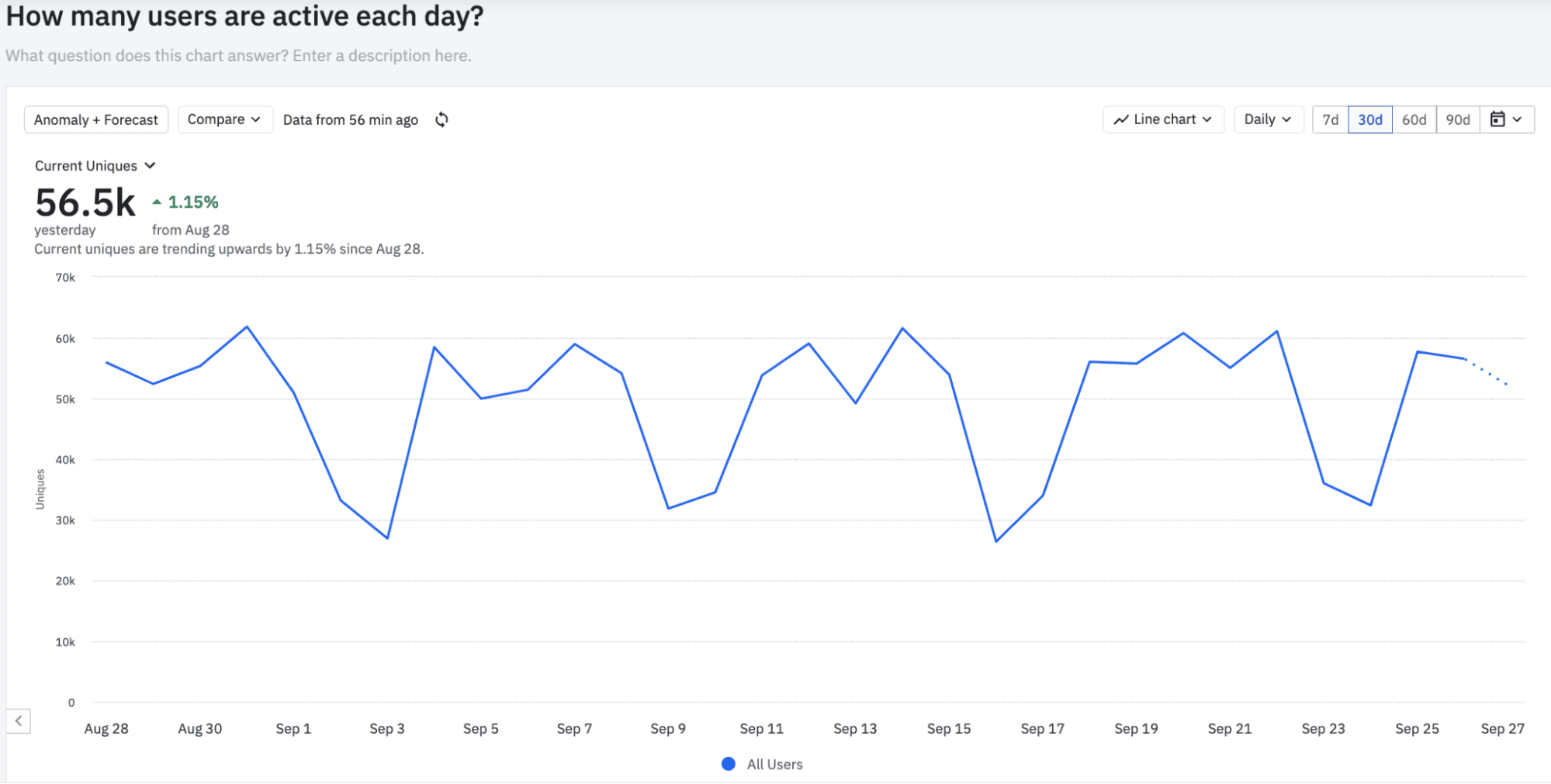Quantitative vs. Qualitative Data: Which To Use and When
Learn the differences between qualitative and quantitative data - one being more subjective, and the other being more objective.
Originally Published on October 27, 2023
Browse by category
Quantitative data is numerical information that can be counted and measured, like the number of daily active users in your product. Qualitative data is descriptive information involving observations, feelings, and opinions that are difficult to measure objectively, like customer reviews.
Not all data is the same. In the case of digital product management, data is a treasure trove—a source of valuable insights that can shape the trajectory of your products and marketing strategies. Within this treasure trove are distinct gems: quantitative and qualitative data.
Understanding how to harness the power of these two data types means the difference between hit-or-miss decisions and finely tuned, user-centric success.
This article explores the importance of each data type in product management and marketing. When combined, quantitative and qualitative data unlock a deeper understanding of your audience and product that can revolutionize your approach.
Key takeaways
- Quantitative data is objective and measurable. It’s numbers-based and teams can use formulas and percentages to make informed decisions about product improvements.
- Qualitative data is subjective and provides contextual insights into user experiences. Product teams use this data for unique insights.
- Product managers and marketers use both data types to get a complete picture of their product analytics.
What is quantitative data?
Quantitative data is measurable and typically expressed in numbers. Leading teams use it to make generalized conclusions about their users so they can make informed decisions. For example, daily active users (DAU) is a quantitative metric that can give you high-level insights about user engagement and activity within your product.
Quantitative data provides insights into:
- Objective user behavior: This data reveals how users navigate your product, what features they use most, and where they drop off, helping you optimize the user experience.
- Product performance: It allows you to track system performance to identify bottlenecks, slow-loading pages, or technical issues affecting user satisfaction.
- Other key metrics: These metrics, often referred to as key performance indicators (KPIs), use quantitative data to gauge the overall health of your product.
Quantitative data empowers you to evaluate the effectiveness of your digital product and make data-driven decisions to improve it. You can create a repeatable process for collecting this data to continuously improve your product and marketing campaigns.
What is qualitative data?
Qualitative data offers a deep, narrative understanding of your current and potential users. Leading companies use strategies like listening to the voice of the customer (VoC) to gather qualitative data via surveys, focus groups, and other feedback mechanisms. It focuses on the user experiences, opinions, and emotions, enabling product teams to grasp the “why” and “how” behind user interactions with your product.
Qualitative data provides nuanced insights into:
- User feedback: Qualitative data includes direct user feedback, like comments, reviews, and open-ended survey responses. It enables you to hear your users’ unfiltered voices to better understand their motivations, pain points, and desires.
- Customer experiences: This type of data often includes user stories and testimonials. These anecdotes provide real-life examples of how your product impacts users, offering valuable narratives to share in marketing materials.
- Competitive advantages and disadvantages: Understanding what users appreciate or find lacking in competing products can inform your competitive analysis.
Qualitative data offers the human side of the story and helps you understand market trends, audience preferences, and emerging needs. This understanding guides product development and marketing strategies.
When to use quantitative versus qualitative data
Quantitative data offers precise, numerical, and often objective information well-suited for measuring performance and success over time. Qualitative data, by contrast, provides in-depth, context-rich, and subjective insights into consumer behavior and preferences. Both types of data have a unique purpose.
Use quantitative data to monitor progress and success
Product managers and marketers rely on quantitative data when assessing success and making informed decisions.
Here’s why quantitative data is so instrumental:
- Objective benchmarking: Quantitative data allows you to objectively benchmark your product’s performance and success against key metrics, industry standards, and competitors. This data-driven approach provides clear, actionable insights for decision-making.
- Data-backed strategies: Product managers and marketers use quantitative data to identify improvement opportunities, allocate resources effectively, and prioritize the features and marketing channels that will deliver the best results.
- Measuring progress: Tracking and monitoring key metrics allows you to assess the effectiveness of your strategies and make necessary adjustments.
Use qualitative data for its unique insights
Qualitative data is just as important to product teams. It offers invaluable insights into users that quantitative data often can’t provide.
Here's the top use cases for qualitative data:
- Understanding your users’ perspectives: Qualitative data helps you understand your users’ emotions and motivations. Surveys, interviews, and user feedback can help you uncover the "why" behind their actions and preferences. This is vital for creating user-centric products and marketing campaigns.
- Uncovering pain points: It can help you identify potential product improvements that you may initially overlook with quantitative data alone. data. Qualitative feedback provides detailed narratives about user experiences, allowing you to address issues more precisely.
- Product refinement: Product managers and marketers use qualitative data to refine product features, user interfaces, and marketing strategies. Real user stories and testimonials are powerful assets for crafting compelling marketing narratives.
Tracking and analyzing qualitative and quantitative data
Quantitative and qualitative data are not mutually exclusive—they complement each other. Both data types are essential for product teams looking for a complete picture of product usage, user behaviors, and preferences. While quantitative data offers the “what” and “how much,” qualitative data delves into the “why” and “how.”
Let’s say a product marketer sees low usage and engagement of a new feature via quantitative data but still needs to pinpoint the problem. The product team surveys customers to gather qualitative insights and the results indicate the feature needs to be easier to use. The product marketer then brings this information back to their developers, who use both data types to reconfigure the feature and add a tutorial to increase ease of use.
The insights from both quantitative and qualitative data are essential if your product teams aim to make informed decisions, create user-centric designs, and ensure user satisfaction throughout the product lifecycle.
Get the most insights from your data with Amplitude
Quantitative and qualitative data combine to create a powerhouse for product managers and marketers. However, it's not just about collecting data—it’s about making data-informed decisions that drive success.
Amplitude is a powerful analytics platform for tracking and analyzing quantitative and qualitative data. Here’s how Amplitude helps you with both:
- Collect: Amplitude can gather product and customer data through integrations with your existing tools. You can also set and track metrics and goals, so your team can deeply understand user behavior to drive growth and mitigate churn. With real-time data collection and reporting, you can immediately access critical insights for making timely decisions.
- Analyze: With Amplitude’s automated reports and real-time visualizations, you can easily spot trends, anomalies, and deviations. These analytics capabilities help you address issues before they impact your business.
- Activate: Amplitude enables your product team to use the insights from your data to take action and make decisions for your business. It also offers industry-specific templates and recommendations.

A chart from Amplitude that shows Daily Active Users. In this chart, the company saw a 1.15% increase in DAU from the previous 30 days. Try this chart yourself in our self-service demo.
Amplitude’s features help you harness the full potential of your quantitative and qualitative data, ensuring your product management and marketing strategies are finely tuned, user-centric, and constantly evolving. With Amplitude, you can unlock the depths of user behavior and preferences, helping your business thrive in the ever-evolving digital landscape.
Try our demo to see precisely how Amplitude helps you make strategic, data-driven decisions. Or sign up for free today.

Pragnya Paramita
Former Group Product Marketing Manager, Amplitude
Pragnya is a former Group Product Marketing Manager at Amplitude. She led the go-to-market efforts for data management products. A graduate of Duke University's Fuqua School of Business, she is passionate about working at the intersection of business and technology and when time allows, cooking up a storm with cuisines from all over the world.
More from Pragnya




